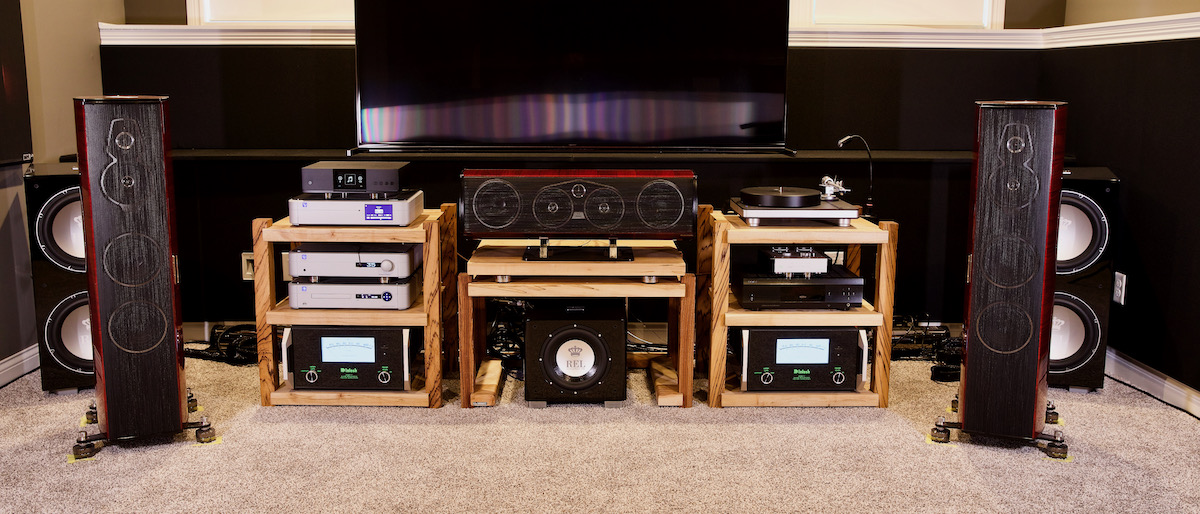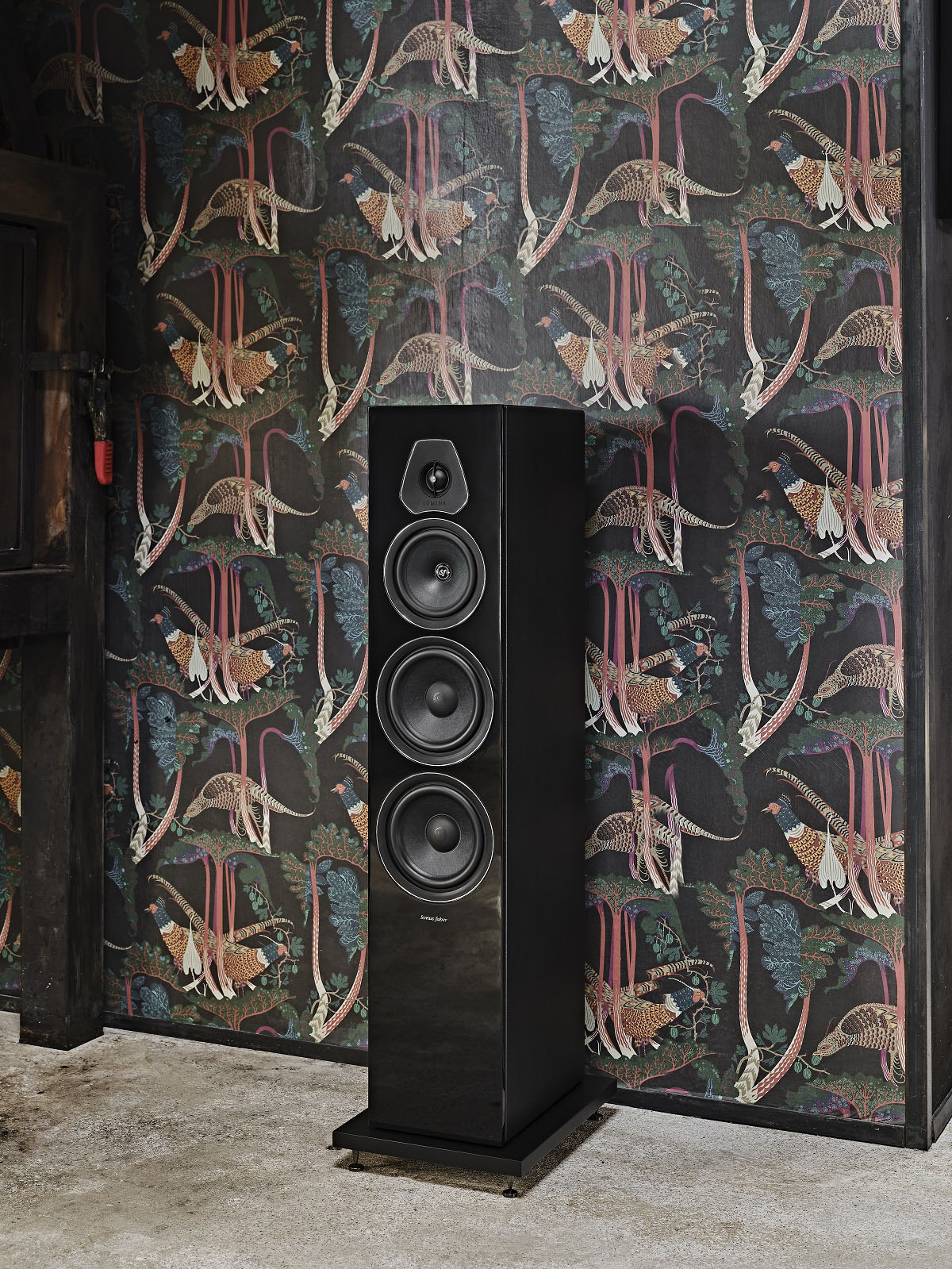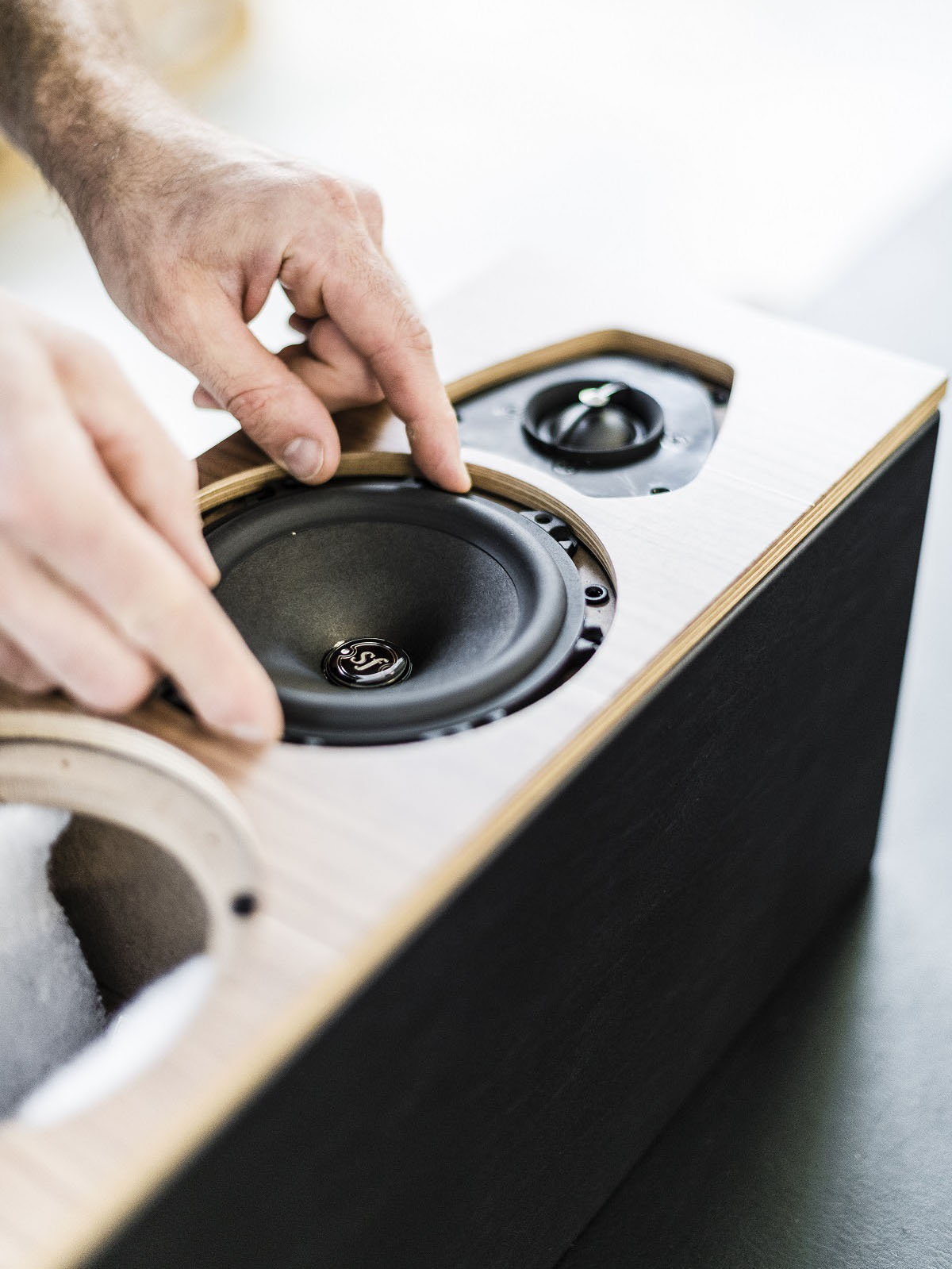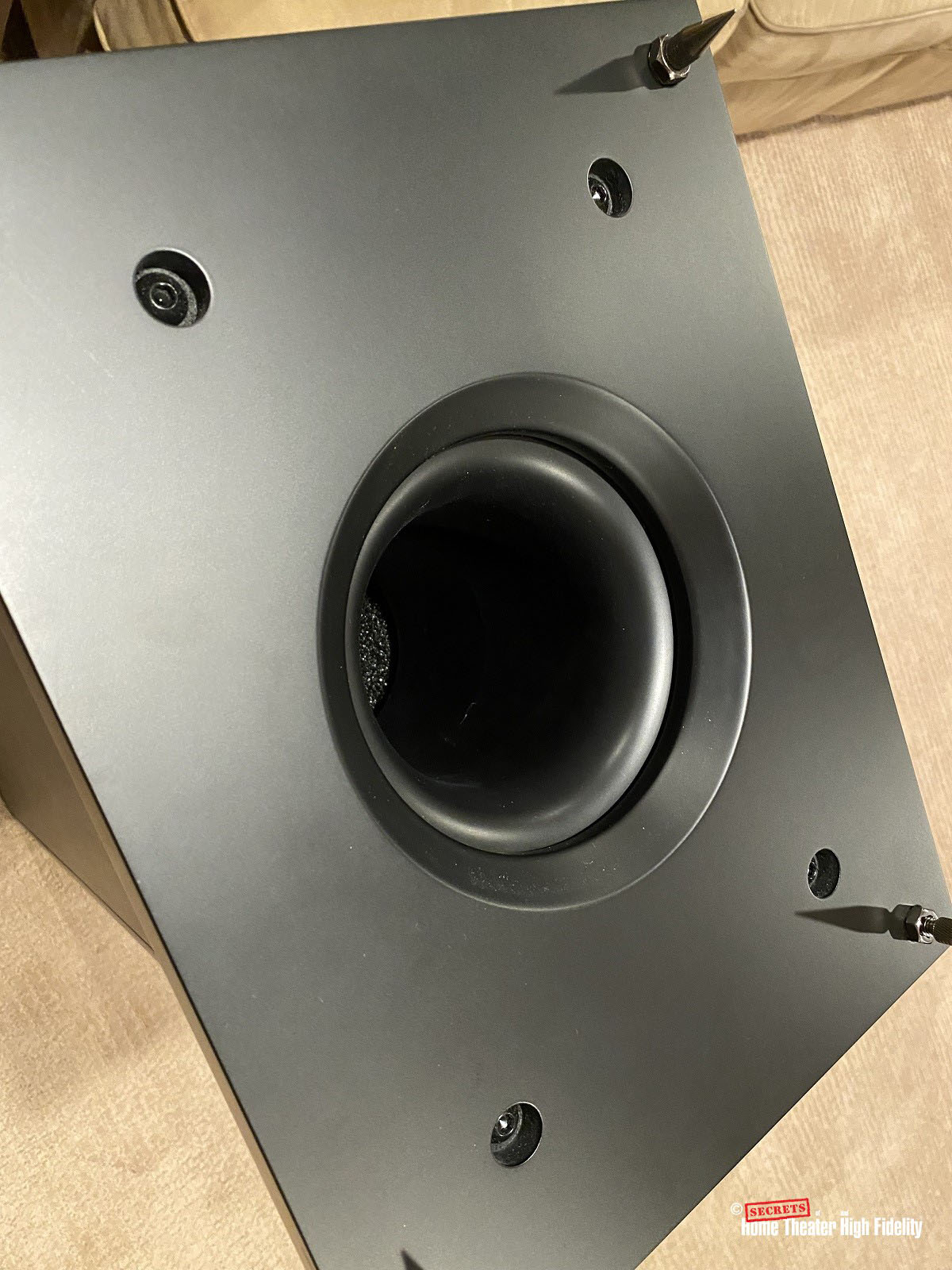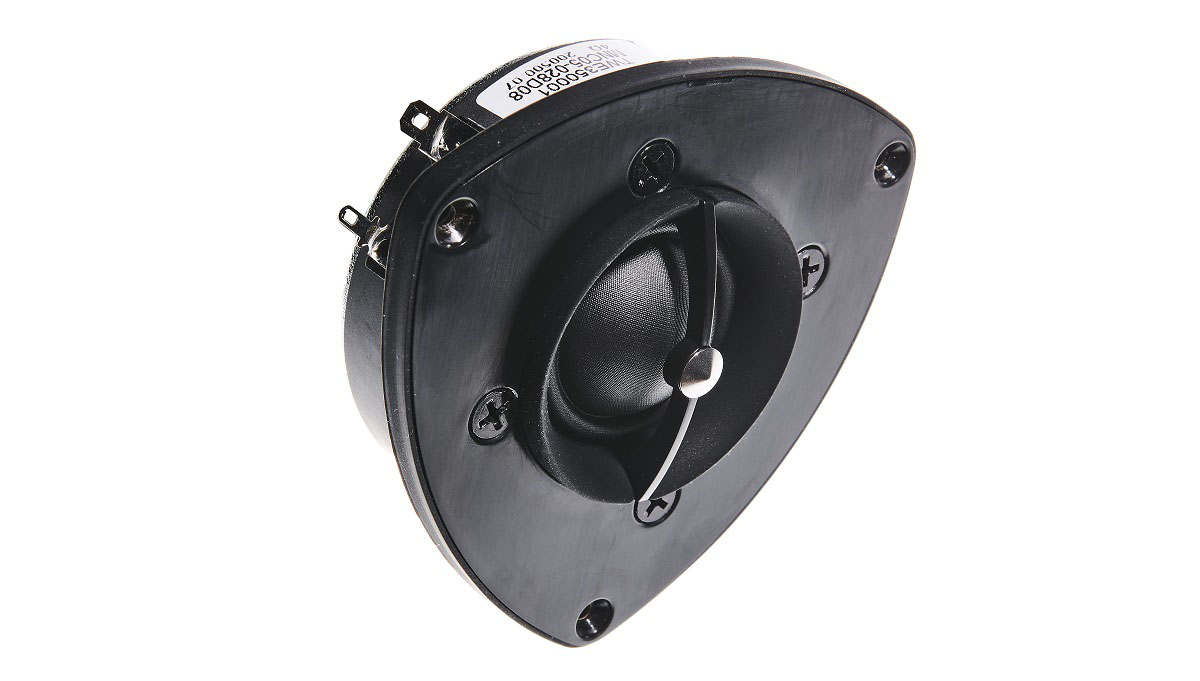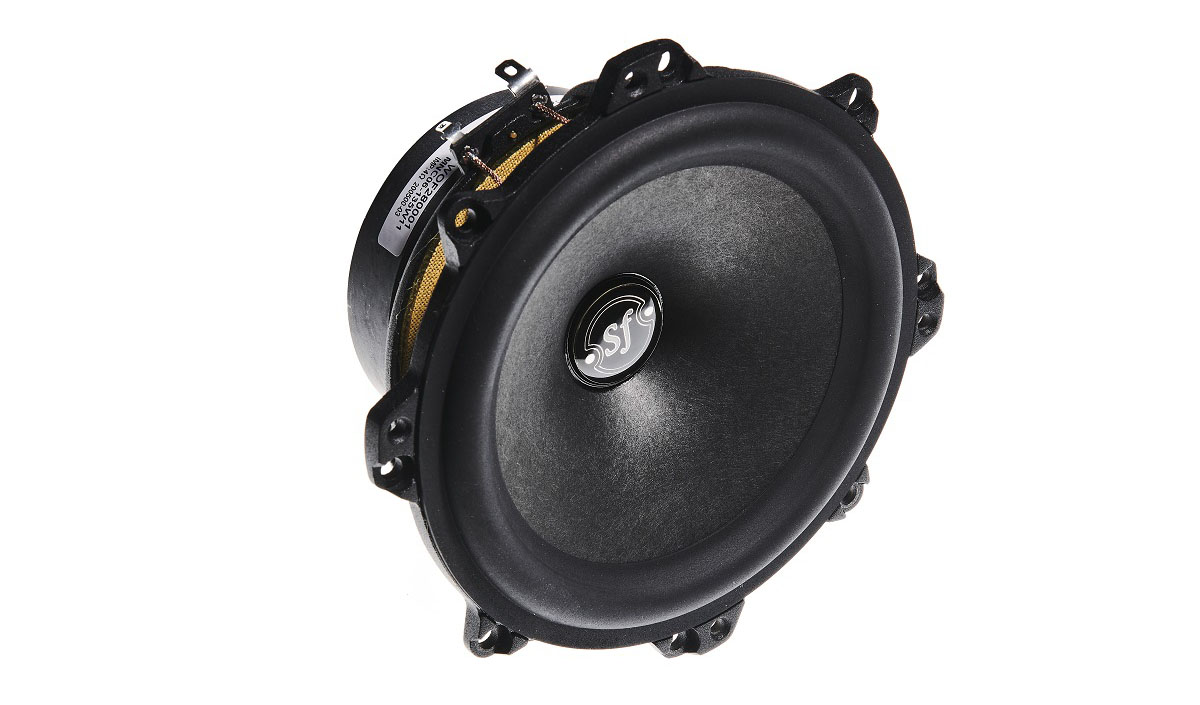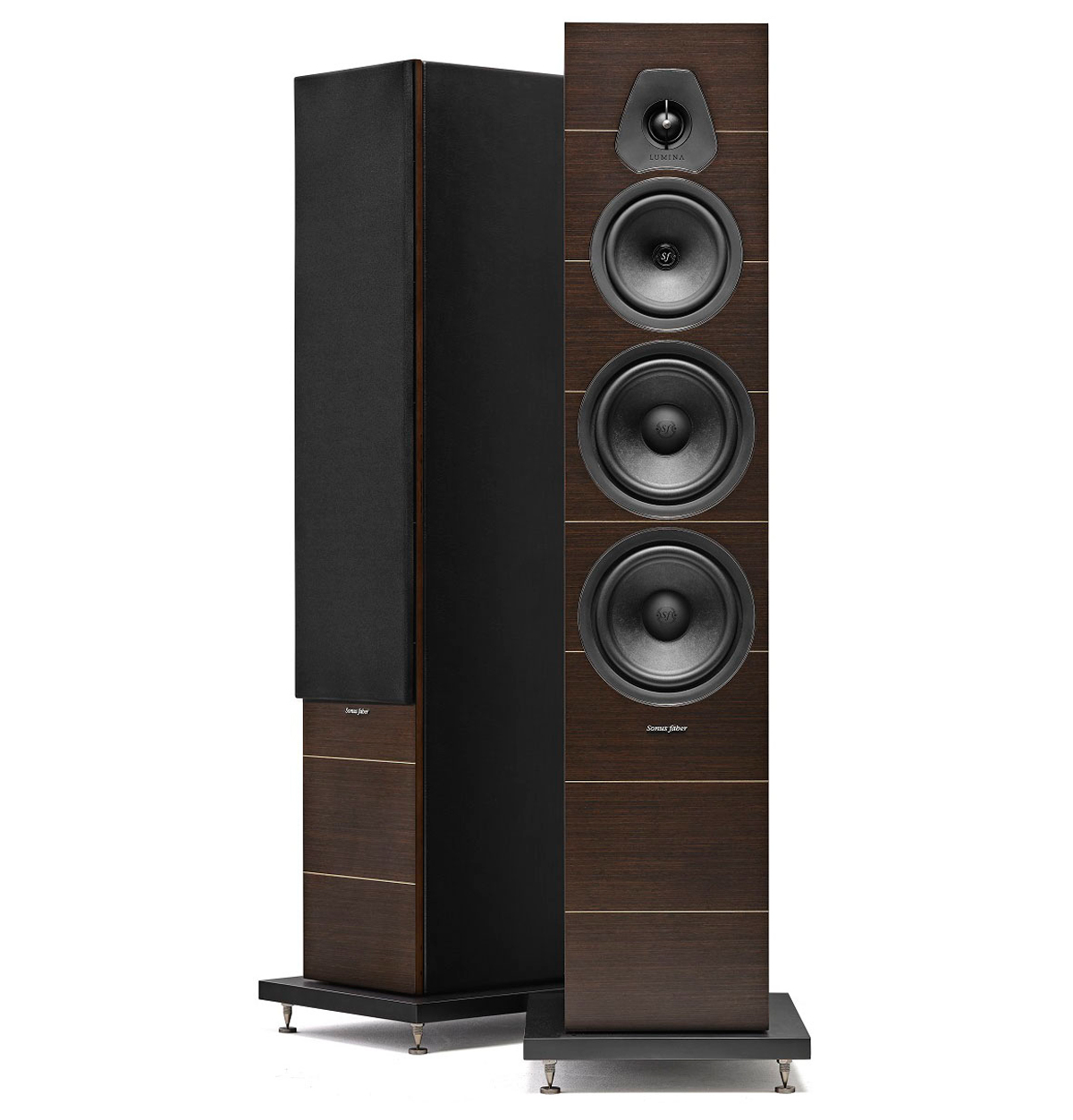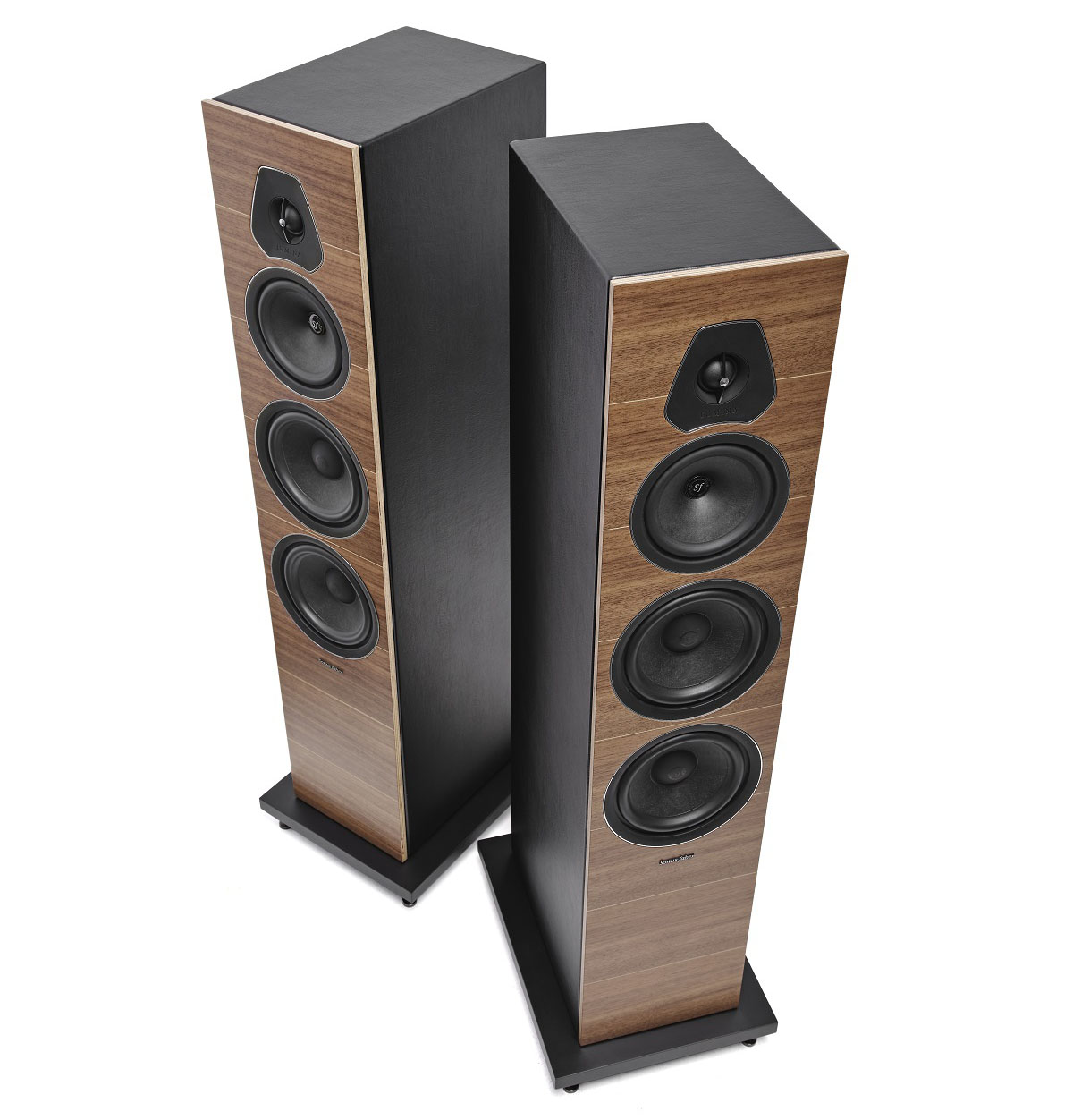Building upon the foundation set by the Lumina III, the Lumina V kicks things up a notch with larger bass drivers, an improved crossover network, and additional cabinet bracing. It’s all gracefully wrapped in a blend of wood and leather that exemplifies Italian craftsmanship. Backing up those good looks is clean treble response, a smooth, musical midrange, and solid bass performance.
Sonus faber Lumina V Loudspeaker
- Straight lines + wood + leather = a simple, yet elegant design
- Solid construction for the price point
- Made in Italy
- The bottom-firing port allows for flexible room placement
- Flattering to even poor-quality source material
- Performance is much closer to high-end offerings than you’d expect
I have had the pleasure of reviewing several Sonus faber speakers over the years, starting with the original Olympica line (which has been my personal reference speaker for many years now) and most recently the refreshed Olympica Nova V and Minima Amator II. I haven’t had a “budget” Sonus faber speaker in for review since the Principia 3 bookshelf speaker back in 2017. While I enjoyed my time with $699/pair Principia 3s, it was pretty obvious that Sonus faber had to make some concessions to hit such a low (for Sonus faber) price point. First, the speakers were manufactured in China, which is quite contrary to the “made by hand in Italy” mantra that is key to Sonus faber’s identity. Aesthetically, they were also fairly plain looking, at least by Sonus faber standards. Additionally, there were some sacrifices in driver quality, with a small loss of smoothness in the upper midrange and treble regions being the most noticeable result.
I was very interested when Sonus faber announced a new entry-level line in 2020 called Lumina. While they were priced a bit higher than the old Principia series, they were still relatively affordable and looked more like a Sonus faber product. The press release also noted that the Lumina line would be manufactured in Italy, which certainly piqued my curiosity. Secrets’ Editor Carlo Lo Raso was able to review the prior flagship of the Lumina line, the Lumina III, a few months ago and was impressed overall. The only real issue he noted was a bit of bass and lower midrange leanness in his room. I wonder if Sonus faber had received other comments concerning the bass because in June they announced an expansion of the Lumina line with the Lumina II bookshelf and the new flagship Lumina V tower loudspeaker, both with larger bass drivers. I received an early pair of Lumina V speakers (serial numbers 003 and 004 to be exact) and spent the past few months putting them through their paces.
Design:
3-way ported tower loudspeaker
Drivers:
1 x 29mm silk Damped Apex Dome™ tweeter, 1 x 150mm midrange, 2 x 165mm woofers
Crossover:
Hybrid IFF-Paracross™ @ 260Hz and 2,600Hz
Frequency Response:
38Hz-24kHz
Sensitivity:
89dB SPL (2.83V/1m)
Nominal Impedance:
4 ohms
Recommended Amplifier Power:
50-300W, without clipping
Dimensions (W x H x D):
11 X 41.3 X 14.6”
Weight:
49.6lbs each
Warranty:
5 years – parts and labor, extends to 8 years if you register at sonusfaber.com within 30 days of purchase
MSRP:
$2,800/pair
Website:
Company:
SECRETS Tags:
sonus faber, lumina v, tower speaker, speaker review
- Sonus faber Lumina III Loudspeaker
- Sonus faber Olympica Nova V Tower Speaker
- Sonus faber Minima Amator II Bookshelf Speaker
As Sonus faber’s least expensive line, the Luminas are subject to a few cost-cutting moves not seen in the brand’s more expensive speakers. First, there are no gracefully curved “lute shape” cabinet walls, which are a long-standing Sonus faber tradition. Instead, the cabinet of the Lumina V is made of straight MDF panels. The side and top panels are covered in soft black leather, while the rear panel is a simple satin black veneer. The front baffle is multi-layered wood with a real wood veneer applied in the case of the walnut or wenge finishes. The walnut and wenge veneers have contrasting stripes of maple wood embedded in them, which gives a very classy appearance, particularly when combined with the matte finish. Piano black lacquer is also available if you are looking for a simpler look.
My samples had the matte wenge veneer and I really liked the look of the dark brown (with a hint of red) wood with the lighter colored stripes. The drivers are surrounded by a thin chrome accent which really makes them pop against the dark wenge wood. Combined with the leather, the Lumina Vs look much more expensive than they are and are definitely the best-looking rectangular boxes I’ve ever seen. Black cloth grilles that attach magnetically are included if you feel the need to cover up the beautiful front face. A black veneered plinth is attached to the bottom of the tower to improve stability. The plinth also houses the down-firing woofer port. Threaded metal spikes screw into the plinth and can be used to adjust the height and rake of the speaker. Fortunately, the spikes were long enough to keep the bottom woofer port from being blocked by my carpet. Sonus faber also includes metal disks to place under the spikes if you need to protect wood or tile flooring. Two pairs of nickel-plated binding posts on the lower back panel round things out and can be used for bi-wiring or bi-amping if one so chooses.
The drivers and internals are where things differ a bit from the Lumina III tower. While the Lumina V sports the same 29mm Damped-Apex-Dome™ tweeter and 150mm paper-coned midrange, the woofers have been upgraded to 165mm (6.5 inches) models from the 150mm/5.9-inch units in the Lumina III. The new units are a sandwich of syntactic foam core on the inside with cellulose pulp and natural fibers on the outside to keep them both rigid and light. Internally, the Lumina V gets a new crossover design, the “Hybrid IFF Crossover – Paracross Technology™” unit. The Hybrid IFF Crossover “combines Interactive Fusion Filtering, first introduced in the Maxima Amator, with the Paracross Topology™, where reactive components (capacitors and inductors/coils) are placed on the negative rail of the circuitry. The resulting benefits include a reduction in the drivers’ back EMF (Electro Motive Force), allowing them to operate in a maximally interconnected and organic way, and lowering of crossover sensitivity to radio frequencies, further improving sound definition.” The other key internal change is the addition of a lute-shaped enclosure for the midrange and tweeter. Not only does this additional enclosure improve the structural rigidity of the cabinet, but it also improves the drivers’ performance by reducing standing waves. This should lead to a more natural midrange presentation.
While I typically struggle to move large tower speakers up the 13 steps to my media room, the Lumina Vs were no problem. Since they only weigh about 50 pounds each, I was able to push the boxes up my steps single-handed. The packaging was solid (though not quite as ornate as higher-priced Sonus faber offerings), and it was very simple to get the speakers unboxed and set up. All I had to do was lay the speakers on their sides to screw in the metal spikes and their accompanying adjustment nuts. The Lumina Vs were then placed in roughly the same position as my reference Sonus faber Olympica IIIs, about eight feet apart and roughly ten feet from my primary listening position. I started off with the speakers about three feet from the front wall of my 22 x 28-foot media room and about four feet from the side walls. The Lumina Vs were connected to my reference Wyred4Sound multi-channel amp (roughly 1000w@4 ohms) via bi-wired Kimber 4VS speaker cable and the amp was connected to a Marantz AV8801 pre/pro via Blue Jeans XLR cables. All music was fed to the AV8801 via an Oppo BDP-205 Universal player, connected to the pre/pro via HDMI and analog XLR outputs for two-channel sources to take advantage of the better DAC in the Oppo player.
Using XTZ’s Room Analyzer II Pro kit along with some reference tracks, I moved the speakers around the room a bit, trying to tweak the setup position. What I found was that the Lumina Vs were very tolerant of different speaker positions, with only a small change in bass response whether I moved the speakers closer to my front and side walls or further out into the room. I ended up with the Lumina Vs about 30 inches from my front wall and 36 inches from my sidewalls, which gave me a good low-end reinforcement without the bass becoming boomy or loose. Even when I had the speakers almost right up against my front wall the bass was still tight, though a bit emphasized in certain regions. I’ve attached a screenshot from the XTZ software I used to help position the speakers. The measurement microphone was positioned where my head would be while sitting in my primary listening position. The aqua bars show the real-time analysis with the speakers 30 inches from my front wall while the green trace shows the response with the speakers 18 inches from the front wall. As you can see, moving the speakers out into the room another 12 inches dropped the peak centered around 50Hz by a good 3-4dB. More surprising was just how much output the Lumina Vs were generating below 30Hz in my room. I had to double-check to ensure that my subs were disengaged and the Marantz pre-pro was in Pure Direct mode, which shuts down the LFE output and all room correction. Everything was running as it should, so the Luminas paired very well with my room. Treble did start a fairly steep roll-off above 10kHz, but that is typical of my room and listening position. However, the Lumina Vs generally stayed within a +3dB range from 160Hz to 10kHz, with only a few points outside that mark. Considering the lack of room EQ, this is pretty impressive. Imaging and sound staging was best with the speakers toed in so that they converged at a point roughly five feet behind my head. I found the tweeter height a little low initially, which seemed to emphasize the treble slightly. To counter this, I tried to dial in some rake by raising the front of the speakers with the screw-in spikes. With the thick carpet in my room, I had to extend the front spikes as far as they could go to get the tweeter aimed slightly above ear level, which smoothed out the treble response just enough for my liking. With the spikes completely extended, they were a bit wobbly but didn’t fall out. I’d love to see another inch or so of adjustment room. I’d also like to note that I did not hear much, if any, real change in the speakers within the first few hundred hours except for a touch more bass extension and speed once the woofers broke in. I also thought that the Lumina Vs sounded just a bit better with their grilles off, so I packed them away for the entire review period.
Secrets Sponsor
With the Lumina Vs set up to deliver their best performance in my room, I got to finally move on to the fun part – listening. I recently watched “Star Wars: The Rise of Skywalker” with my sons and while the movie itself was a bit of a letdown, I really enjoyed certain pieces of the soundtrack. I had downloaded the 192kHz/24-bit FLAC version of this score from HDTracks months ago so this was the perfect chance to check out the files. While there are a few really good new pieces introduced to the Skywalker saga from this film, Track 19, “Finale,” is basically an 11-minute long “best of” mini-score from the movie. Through the Luminas, the overall sound was incredibly clear. Starting around the 3:00 mark, the score shows some impressive dynamics, with the brass and wind sections shooting up from the mix with authority. At the 3:26 mark the track shifts into the “Imperial March” which sounded superb. The brass was appropriately bright but was not fatiguing. As I’ve come to expect from Sonus faber designs, winds sounded full and natural, sweeping in beautifully at key moments.
The subtle chimes that ring in conjunction with some of the musical peaks had a nice shimmer to them, showing off the smooth performance of the DAD™ tweeter. Perhaps even more impressive was the bass response, with the tympani hits coming through deep, fast, and with lots of driving force. I could easily hear (and feel) the fluttering reverberation of the drum skins with each hit. Right around the 9:25 mark, there was some excellent midrange detail on display as well, with plucked harp notes shining through in the mix. The sound field was expansive, and I could easily discern where some of the instruments were placed on the stage. John Williams really is a master of his craft and I wonder if anyone else will be able to fill his shoes now that he has left the Star Wars universe for good. Fortunately, the Lumina Vs really did John Williams’ swan song to the series justice.
Moving on to some female vocals, I loaded up Melody Gardot’s latest album, “Sunset in the Blue” (96kHz/24-bit FLAC, www.hdtracks.com) and went straight to the title track. Right from the start, I was grabbed by not only how clean and articulate the guitar sounded, but the richness of the tone. Then the bassline kicks in and I was floored with how the Lumina Vs sounded. The natural bass was incredibly deep and tuneful. I really didn’t feel like the Lumina Vs needed a sub, which is surprising as I consider myself a true bass-junkie. Ms. Gardot’s sweet vocals sounded fantastic, with the close-miked recording capturing her diction and phrasing wonderfully. There was a nice sense of body to her voice and the Lumina Vs placed the vocal firmly in the center of the soundstage. The other instruments seemed to sit slightly behind the vocals and were nicely spread out across the front soundstage. You could also hear the high-hats from the drum kit vibrating in the background due to the deep natural bass. It all combined to pull me deep into the mix, making it feel like I was sitting in the room during the recording session. “Little Something” is another great track on this album, featuring vocals by Sting. Through the Lumina Vs, it was easy to hear the difference in how Sting’s vocals were recorded, with his voice sounding brighter and very thin in comparison to Gardot’s far richer and more natural sound. The bassline is killer on this track, with a quick bopping beat that hit hard through the Lumina Vs.
Moving into a bit more “pop-ish” territory, I queued up Gary Clark Jr’s. “Feelin’ Like a Million” from “This Land” (96kHz/24-bit FLAC, www.hdtracks.com). This is a really fun song that combines a reggae bass line with Clark’s more standard blues/rock fare. It is also best served up loud. The thumping bass hits hard right off the bat, and the Lumina Vs delivered the rolling bassline with clear definition and power. I could feel the thump of the bass notes in my chest. Clark’s vocals came across exceptionally clear, nicely capturing the hint of grit he has in his voice. And being a Gary Clark Jr. song, some nice blues-based guitar riffs come cutting through. Clark’s signature distortion tone was well-represented by the Lumina Vs, with the guitar sounding sweet and clear but still appropriately aggressive. Raising the volume up towards the 95dB mark displayed no stress on the part of the Lumina Vs, with the overall sound maintaining its clarity and balance. I didn’t pick up on any audible distortion creeping into the sound. The Luminas really seemed to like the kilowatt of power I was feeding them, so don’t worry about your amp being too powerful. If you are someone who likes to throw a good party, the Lumina Vs can certainly rock out.
Secrets Sponsor
Just as I was about to submit this review, I heard the news that ZZ Top bassist Dusty Hill had passed away rather suddenly. As a huge fan of ZZ Top, this hit me pretty hard. So, it only seemed fair to wrap this up with some select tracks that highlighted Dusty’s fantastic playing and vocals. I pulled out my “Chrome, Smoke, & Barbecue” CD set (CD, Rhino B0000CF35L) and started loading discs. “Tush” off of 1975’s “Fandango!” is probably Dusty’s most famous lead vocal and also happened to be ZZ Top’s first Top 20 hit. The Luminas truly helped Dusty’s voice shine. I could hear his very controlled vibrato at the end of each phrase as well as some of the very subtle inflections that he injects to add a little extra character to certain words. Billy Gibbons’ slide guitar solo towards the middle of the song had just the right amount of twang cutting through the overdrive and I could pick up on the many different notes that Gibbons utilized. “Cheap Sunglasses” off of 1979’s “Deguello” is a great example of Dusty’s incredibly tight bass work. This track sounded even better than “Tush” with a lusher recording quality. At first, you don’t think that the bassline is that complex, but if you listen closely, you can hear that there are a lot of notes in there. The tight bass response of the Lumina’s made it very easy to hear each and every note that made up the low end of this classic song. The drums are not as present in early ZZ Top recordings, but they still hit nice and tight. The Lumina Vs presented ZZ Top’s “Texas boogie” with flair and I wound up listening to quite a few more tracks, really enjoying the experience. While Dusty Hill will be greatly missed, I hope that ZZ Top can find a way to continue on.
Elegant looks with very good overall performance makes the LUMINA V the best performance-for-dollar speaker I’ve yet heard from Sonus faber. Even more amazing is that they’re building them in Italy for this price.
- Musical presentation without being dark or dull sounding
- Detailed, yet smooth treble response
- Full sounding midrange with just a hint of sweetness and warmth
- Tight and deep bass response
- Impressive imaging and sound staging for the price
- A bit more range of motion for the carpet spikes
- At this price? Nothing
Without a doubt, the Sonus faber Lumina V is the best “budget” loudspeaker Sonus faber has yet made. I listened to a lot of different music in the two months that I had them in my home, and they were able to make everything sound good. The Lumina Vs combine Sonus faber’s trademark Italian design and build quality with a really big dose of the accurate, yet musical house sound inherent in the brand’s more expensive models. With their smooth treble, full midrange, solid bass response, and excellent imaging the Lumina Vs have no real flaws. Even better, the Lumina V should be an option for a far wider audience due to its more affordable price point. While there are a lot of competitors in the speaker market at the Lumina V’s $2800 per pair price point, I dare you to name another speaker that sounds this good and looks this fantastic.


